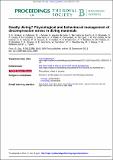Deadly diving? Physiological and behavioural management of decompression stress in diving mammals
Abstract
Decompression sickness (DCS; 'the bends') is a disease associated with gas uptake at pressure. The basic pathology and cause are relatively well known to human divers. Breath-hold diving marine mammals were thought to be relatively immune to DCS owing to multiple anatomical, physiological and behavioural adaptations that reduce nitrogen gas (N-2) loading during dives. However, recent observations have shown that gas bubbles may form and tissue injury may occur in marine mammals under certain circumstances. Gas kinetic models based on measured time-depth profiles further suggest the potential occurrence of high blood and tissue N-2 tensions. We review evidence for gas-bubble incidence in marine mammal tissues and discuss the theory behind gas loading and bubble formation. We suggest that diving mammals vary their physiological responses according to multiple stressors, and that the perspective on marine mammal diving physiology should change from simply minimizing N-2 loading to management of the N-2 load. This suggests several avenues for further study, ranging from the effects of gas bubbles at molecular, cellular and organ function levels, to comparative studies relating the presence/absence of gas bubbles to diving behaviour. Technological advances in imaging and remote instrumentation are likely to advance this field in coming years.
Citation
Hooker , S K , Fahlman , A , Moore , M J , Aguilar de Soto , N , Bernaldo de Quiros , Y , Brubakk , A O , Costa , D P , Costidis , A M , Dennison , S , Falke , K J , Fernandez , A , Ferrigno , M , Fitz-Clarke , J R , Garner , M M , Houser , D S , Jepson , P D , Ketten , D R , Kvadsheim , P H , Madsen , P T , Pollock , N W , Rotstein , D S , Rowles , T K , Simmons , S E , Van Bonn , W , Weathersby , P K , Weise , M J , Williams , T M & Tyack , P L 2012 , ' Deadly diving? Physiological and behavioural management of decompression stress in diving mammals ' , Proceedings of the Royal Society B: Biological Sciences , vol. 279 , no. 1731 , pp. 1041-1050 . https://doi.org/10.1098/rspb.2011.2088
Publication
Proceedings of the Royal Society B: Biological Sciences
Status
Peer reviewed
ISSN
0962-8452Type
Journal item
Collections
Items in the St Andrews Research Repository are protected by copyright, with all rights reserved, unless otherwise indicated.

